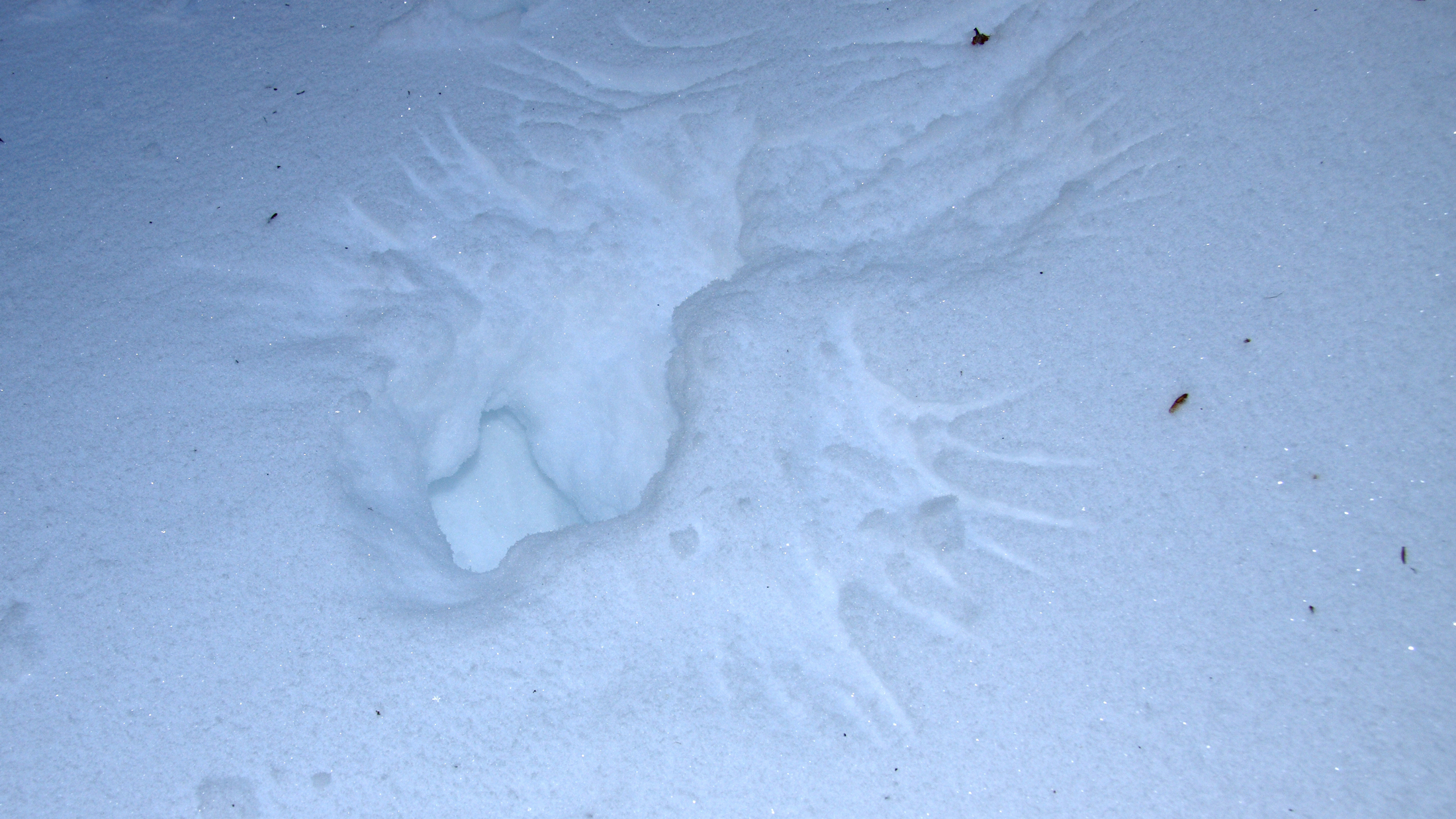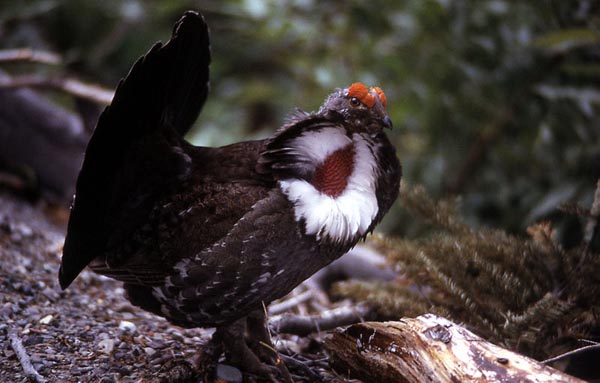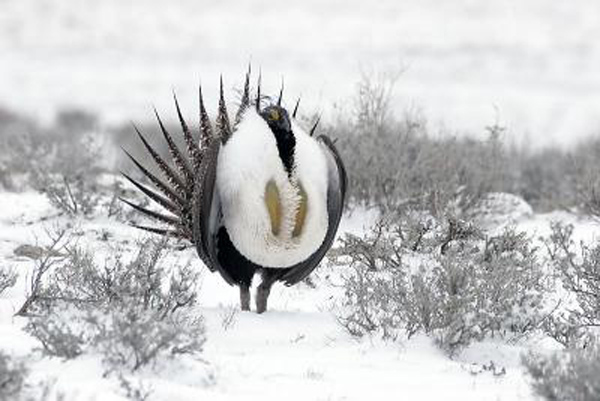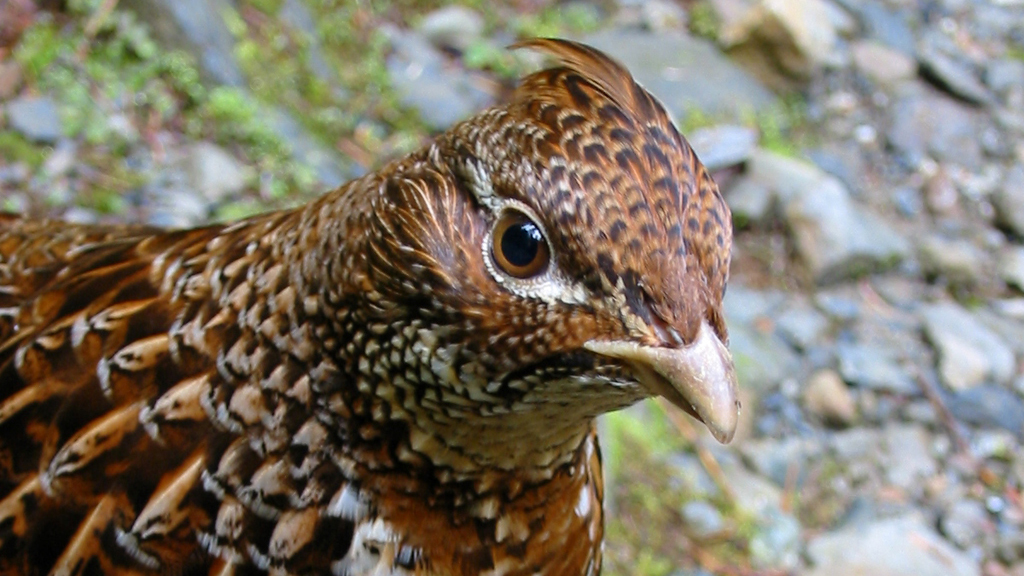When the snow starts falling, many wild creatures start moving towards more benign environments.
Not so with certain grouse species. They’re adapted to thrive in deep snow and cold weather – provided they have healthy habitat.
Given the interest in the recent blog explaining how the polar vortex affected wildlife, this week I’ll look at how three North American grouse species survive the deepest snows and coldest temperatures.

Ruffed Grouse
As is the case with skiers, ruffed grouse love powder. When the snow is fluffy, this bird creates one of winter’s most unusual wildlife shelters.
Forget moving out of the snow; ruffed grouse plunge into it.
The ruffed grouse flies along and dive bombs head first into deep, fluffy snow – completely submerging itself. Its body heat then creates a sealed dome under the snow: essentially, its own igloo.
This structure allows the grouse to stay warm even in the most inclement conditions. Research shows that the snow shelter can warm to 32 degrees Fahrenheit, and rarely drops below 20 degrees — even when it’s much colder outside.
The ruffed grouse is found in many forested areas of North America, so it’s the grouse you’re most likely to see on winter wanderings.
In fact, numerous stories exist of grouse “exploding” out of the snow when a skier or snowshoer approaches – surely a dramatic sight, and one I always hope to see on my own winter outings. However, I’ve never seen a firsthand report, so it’s unclear how often this really happens.
Unfortunately, a snow shelter is not without risks for ruffed grouse. Researchers have found instances when a crust forms on the snow, trapping the grouse inside. If the crust lasts too long, the grouse is unable to escape and dies.
Grouse do have other adaptations for surviving the winter: in September, they grow extended scales on their toes, functioning as snowshoes when the snow is deep. These scales fall of in the spring.

Dusky Grouse
When you picture winter wildlife migrations, you probably see wildlife moving away from heavy snow and cold temperatures. Birds and dragonflies head south for the winter. Elk and mule deer move from high to low elevations.
But dusky grouse do the reverse. They actually migrate to high altitudes and heavy snows.
These grouse are found in the Rocky Mountains and western Canada. In the summer, they feed on forbs and insects in low elevation foothills. As winter approaches, they start heading high up into the mountains.
There, they’ll live in the boughs of pine trees. And while their summer diet is diverse, in winter they’ll exclusively dine on pine and fir needles (and only the outer two-thirds of the needles).
Why would an animal move to snowy and harsh conditions? It’s likely to avoid competition. Lots of species take refuge in the valleys and foothills, and they compete for precious calories to survive the winter. In the high mountains, dusky grouse have an untapped nutritional source all to themselves.

Sage Grouse
This one is simple: Sage grouse need sagebrush. Period.
Sagebrush is important to sage grouse all year. In winter, it’s critical for survival, as the grouse eat sagebrush almost exclusively. It’s a highly nutritious plant (and not just for sage grouse; mule deer, elk and pronghorn also rely on it).
Some range managers still believe the myth that sagebrush gets “decadent.” Essentially, they think it the plant gets too big and thick. But big, “decadent” sagebrush provides important shelter for grouse under its branches, protecting them from snow, ice and wind.
Sage grouse begin their dramatic spring courtship display before the snow melts across much of their range in the American West.
The loss of sagebrush habitat has led to the sage grouse’s well-publicized decline. That’s why the Sage Grouse Initiative focuses on proactive methods, partnering with ranchers, to protect sage grouse habitat—ensuring that the birds have the food and cover they need year round.cy.




I just stepped on a grouse in my wooded backyard. I was outside checking on all the deer beds. I had counted 38 and was walking back up a slope when I stepped on the grouse, it flew up to a nearby tree. It sure startled me.
I would like to know if spruce grouse use the same winter under snow shelter for more than one night
I live in S. Blaine County, Idaho, where “the desert meets the mountains”, and have had the pleasure of the company of a group of grouse, not sure what kind, i don’t think they are sage grouse, but due to extreme amounts of snow this year, i would like to supplement their foraging attempts. Some twig/buds are available, and some sage brush, but i would like to help them stay near cover as they are so obvious on open snow fields…thanks for any suggestions.
Thanks for your story on the wonders of wintering wildlife. As a professional wildlife ecologist I have witnessed all three of these grouse species explode from their fluffy snow shelters. Once my friends and I stopped on a sagebrush ridge in the Owyhee mountains to let our dogs out for a break. The dogs went on point on a patch of snow cover sage. We thought why are they pointing a pile of snow? To our surprise 25 sage grouse exploded in the air. Then when one young dog ran forward more flocks emerged out of the winter wonderland. In total we observed 9 more flocks flush from their hiding places. Over 200 fat and happy sage grouse were under a blanket of snow feeding on their favorite low sagebrush species. I have observed flocks of sharptail grouse do the same in snow cover snowberry patches in South Dakota.
Just had the experience of a grouse exploding out of the newly fallen snow in the foothills outside of Boulder, CO. I was skiing along and noticed three large holes in the snow and wondered what had made them. I gently poked at one and out the bird popped in a whirl of feathers. It was an amazing site as it burst out of the snow and flew off into the trees!
I experience the ruffed grouse “expoloding” out of the snow today! I was hiking along on my 30 acres of land in Central New York. I heard a large bird fly off – I assumed that it had been in a tree and I did not see it. I paused and looked around. Then I started walking again. Boom! The ruffed grouse flew out from just three feet ahead of me. It flew straight up and flew off. I hardly saw it happened so fast! I did not know that grouse did this, but it was obvious when I looked at its hole in the snow. The grouse had been there for a day or two as there were several droppings. As for the first bird that I heard, it may have been another grouse, but I am not sure.
The reason I’m on this page is I just had a grouse explode out of the snow three feet from my snowshod feet. Sharbot Lake Ontario
Had a group of seven ruffed grouse dive bombing and hiding in the snow on my land in Roberts Idaho. Did not know what they were at first, but googled it and found out. My wife and I watched and photographed in amazement. It as a great Christmas present.
Saw group of ruffed grouse in Northeast penna. Pop out of a snow cave were all in there together!
Fascinating and very well written post. Thank you Matt! I clearly need to go out on some nighttime snowshoe expeditions on the off chance I might encounter a buried ruffed grouse 😉
While reading the interesting Grouse article, a pair of Pileated Woodpeckers flew onto 2 of our backyard trees. We live on the edge of Prince William forest, fortunately, as otherwise, I don’t think I’d get this opportunity. I haven’t seen a Pileated since vacationing in the Wisconsin Peninsula State Park near Fish Creek, WI North of Green Bay in 1995. Really made my day!
Nice to see ruffed grouse winter behaviour getting some attention. The shelter you describe actually has a name. It’s called a kieppi. It’s a Finnish word. I have found several over the years and have had one experience of a grouse exploding out of the snow in front of me when I was taking a nighttime snowshoe. Definitely gets the heart pumping.
Love grouse. Do not recommend eating a dusky after they have switched to a pine needle diet … think turpentine. I do disagree that sage brush getting decadent is a myth. If a stand of sage brush gets to large and thick with no understory then the forbes and grasses disappear and also the non-winter cover and food source. You will find very few sage grouse in that habitat. Mixed mosaic sage stands are the best for the birds. Also in the winter you will find them near and in low black sage whenever they can find it that is their preferred winter food not the big tall sage.
As a big fan of wild grouse,thanks for this post. Grouse are interesting birds and their adaption to specific habitat is always a moral lesson in preserving a quality environment for wildlife.
Awesome post! Very interesting! (birds are so cool!)